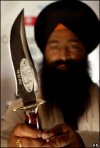- Joined
- Feb 23, 1999
- Messages
- 4,855
I recently stumbled on a Wikipedia article on the kirpan. The concept is much broader than I realized. Here are a couple of quotes from the article.
And another slightly different angle from the same article.
This seems like a noble ideal, and one perhaps not so different from the attitude of many here on Bladeforums.
However, such idealists may be on a bit of a collision course with modern governmental constraints.
One has to wonder why acting in such an ethical manner might be legal for members of one religion, but not for atheists.
The government ruling in the NYC schools referenced above says "Sure, you can wear your kirpan as long as you do something to it that makes it not a kirpan." Here's an old piece from the Huffington Post that addresses that issue.
The kirpan has both a physical function, as a defensive weapon, as well as a symbolic function. Physically it is an instrument of "Ahimsa" or non-violence. The principle of ahimsa is to actively prevent violence, not to simply stand by idly whilst violence is being done. To that end, the kirpan is a tool to be used to prevent violence from being done to a defenseless person when all other means to do so have failed. Symbolically, the kirpan represents the power of truth to cut through untruth. It is the cutting edge of the enlightened mind.
A baptized Sikh, better known as a Khalsa Sikh is a "Sant-Sapie" - a Saint-Soldier: A saint first and then a soldier. So to satisfy this term, one must first become a saint and then a Soldier. As a saint one must have total control over ones internal vices and be able to constantly be immersed in five virtues as clarified in the SGGS. Only then can a Sikh become a soldier. Also, the Khalsa is "Akal Purakh de fauj" - the Army of God. Guru Gobind Singh clearly choose these words very deliberately - He did not state that the Khalsa was the army of the Khalsa or an army of the Sikhs or the army of Punjab - but an Army of God whose function was the protection and safeguarding of all the peoples of God regardless of religion, race or creeed.
And another slightly different angle from the same article.
The breakup of the word is "Kirpa" which means "Grace" and "Aan" which means "Sovereignty". Grace onto the weak\defenceless and Sovereignty of the Khalsa. So as per the the concept any thing which does not adhere to the above two virtues does not qualify to be called as a Kirpan. The ideals of the holder and the capacity of the weapon are prime here. An individual may have a great weapon at his disposal but his\her motives may not be noble and sovereign. Neither he\she qualifies as a Sikh nor his\her weapon as a Kirpan. Again, he\she may possess the ideals i.e he\she is a Sikh but his weapon is ineffective for defence or upholding the sovereignty of the Khalsa. The weapon in this case is not a Kirpan.
So, one particular weapon cannot be labeled as a Kirpan but any object or any weapon which is capable of delivering justice and upholding the sovereignty of Khalsa, becomes a Kirpan.
This seems like a noble ideal, and one perhaps not so different from the attitude of many here on Bladeforums.
However, such idealists may be on a bit of a collision course with modern governmental constraints.
There have been several court cases in states of the USA relating to the legality of wearing a kirpan in public places. Courts in New York and Ohio have ruled that banning the wearing of a kirpan is unconstitutional.[12] In New York City a compromise was reached with the Board of Education whereby the wearing of the knives was allowed so long as they were secured within the sheaths with adhesives and made impossible to draw. In recent years the Sikh practice of wearing a kirpan has caused problems for security personnel at airports and other checkpoints; security personnel may confiscate kirpans if they feel it is necessary, but are advised to treat them with respect.[13] Sikh leaders chose not to attend an April 17, 2008 interfaith meeting with Pope Benedict XVI at the Pope John Paul II Cultural Center in Washington, DC rather than remove the kirpan.[14]
One has to wonder why acting in such an ethical manner might be legal for members of one religion, but not for atheists.
The government ruling in the NYC schools referenced above says "Sure, you can wear your kirpan as long as you do something to it that makes it not a kirpan." Here's an old piece from the Huffington Post that addresses that issue.





